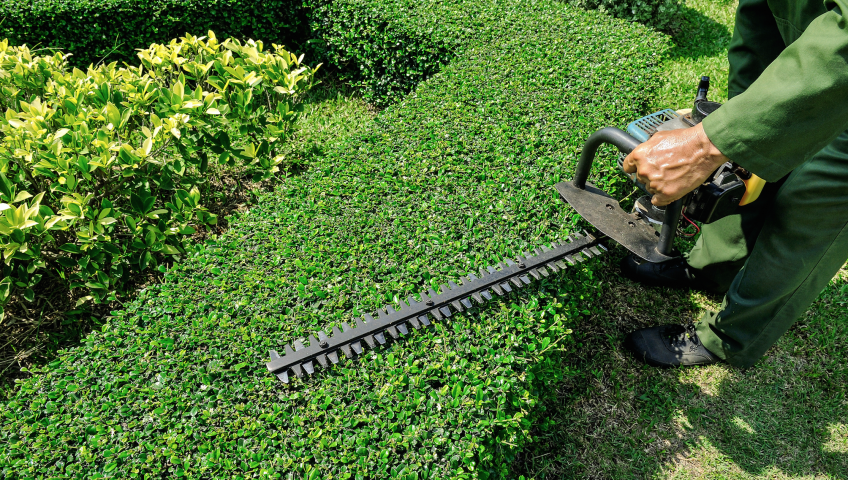How to Get Started With High Paying Landscaping Jobs

If you want to take your small-time grass-cutting business to the big leagues, you have to start getting higher-paying jobs. You also have to expand the services you offer. What happens when you are a trusted company in an area that can do every single task a customer needs, is a much higher paying total package type of job. These jobs can get to well over twenty thousand dollars, but I would not plan on starting at twenty thousand, you have to work your way up.
Start Small
If you are just starting out in the landscape game, you have to keep it small until you figure out what you are doing. Start by cutting grass, then expand into shrubs, gutters, edging, replanting, etc. Start figuring out how to do these jobs effectively, and when you eventually are able to hire workers, you will know how to do it the right way and you can teach them. The last thing you want is to be working a high-paying job and have one of your employees completely botch their part.

Work Your Way Up
After you have the basics of your landscaping business down, you can start to do these package jobs. Do not get intimidated though, the huge jobs are just a bunch of little jobs all in the same place. When you start offering these package deals, you will probably undersell yourself, but that is okay when you are working your way up. You can start with a five hundred dollar job and then a thousand dollar job, then two thousand, and the snowball will just keep getting bigger and bigger until you are regularly working ten thousand plus dollar jobs.
You Need Man Power
While you are working semi-small jobs for around one to two thousand dollars, you may be able to do it all on your own if you are working really hard. However, as you work your way up you are definitely going to need some help. When you start working bigger jobs, you will want to hire a few helpers that know what they are doing. You will also need to train them and work with them to make sure they can do what you ask of them. If you have to hold their hand and tell them how to do everything all the time, you are better off doing it on your own.

It will not be too hard to get some young guys hired that want to make a few extra dollars. You can pay them by the hour or by the job, but you need to keep track of what you are paying to who. I also recommend you get a tax accountant, because if you pay these employees under the table it will eventually catch up with you and them, and no one wants the IRS to come knocking on their door. A tax accountant will be able to sort everything out and will help you pay the taxes you need to pay, as well as issue the correct tax forms to your employees as needed.
The Big Leagues
Once you break through the smaller jobs, you are ready for the big leagues. These jobs can easily pay over ten grand and are exactly the type of jobs you want to focus on. They are going to have the highest profit margins and will overall make you the most money if you do it right.
To start off, we want to try and secure a fifty percent profit margin. So after you have come up with a landscape design, you need to price out everything. How much it cost to rip out old material, how long it takes to plant new bushes or flowers in their place, the price of the plants themselves, how much you have to pay workers, etc. After you plan out everything and know how much it will cost, double that. You may also want to add a little wiggle room in there because you definitely forgot something. So try to secure a sixty percent profit margin.

Here are just a few costs that you may want to consider
- The time it takes to complete the job
- Paying employees
- Plant removal
- Cost of new plants
- Mulch
- Soil/peat
- Weed barrier fabric
- Cost of other misc jobs like gutters or trimming
- Waste dumping costs
You can see how the cost of these total makeover jobs can get fairly expensive fairly quickly. It may cost you five thousand to do the job, but if you get paid eleven thousand it is very worth it. You should also take a deposit from the customer before you get started. This will help with the initial material costs. Then take another chunk of the final payment when you actually get guys on the job site. Then you should have enough to buy all the materials you need. You can take the deposits however you like, but I like about twenty percent as a deposit, and forty percent when we get guys on the site and they start working. Then the rest is collected at the end of the job. If they want to add onto the job in the middle of it, that is fine, but make them pay for that immediately.
Another point I want to make is, just because you would not pay someone the price you need to charge for your service, does not mean other people are not willing to pay it. To me, ten or twenty thousand dollars sounds like an astronomical amount of money to pay a landscaper, and as a hard-working landscaper/ small business owner, you probably think the same. However, there are hundreds of thousands of people across the United States willing to pay whatever you charge. After all, if you are not making a solid amount of money on these big jobs, they are really not worth your time or stress.
Plan Out Your Days in Phases
Planning out your days not only helps keep you organized, but it also makes the customer feel better. If you can give them a timeline and tell them exactly what you will be doing on each day of the job, they will be much more comfortable with the whole process.
After you have sold the customer on the idea of a large job, and you have both agreed on the work that you will do as well as a price, it is time to start your planning. You always want to start your phase with a day for gathering materials. This gives you plenty of time to gather everything you need and bring it to the job site. Then your phases will vary based on the job. For example, if you are redoing their landscaping, your first phase may be to rip out the existing plants and the next phase will be planting the new ones. You will also always have a trimming and grass cutting phase, which may be able to be done alongside other jobs.
You also want to make sure you give yourself a few buffer days to complete certain projects. Trust me, not everything is going to go according to plan. For example, if you think you can do a job in five days and you tell the customer five days, and something happens and you have to take six days, well the customer may not be very happy about that. On the other hand, if you included one or two buffer days in your estimate, the customer will think you finished early and they will be very happy about it.
Conclusion
All and all these jobs will be as complicated as you make them. You have to work your way up from small jobs and getting your business established, but once you get over the hump of one to two thousand dollar jobs, you can start working these higher-paying jobs. Now is it as easy as it sounds? No. Although it is doable, and with the correct planning and mindset you can do it. Always remember your results will never outperform your mindset.

